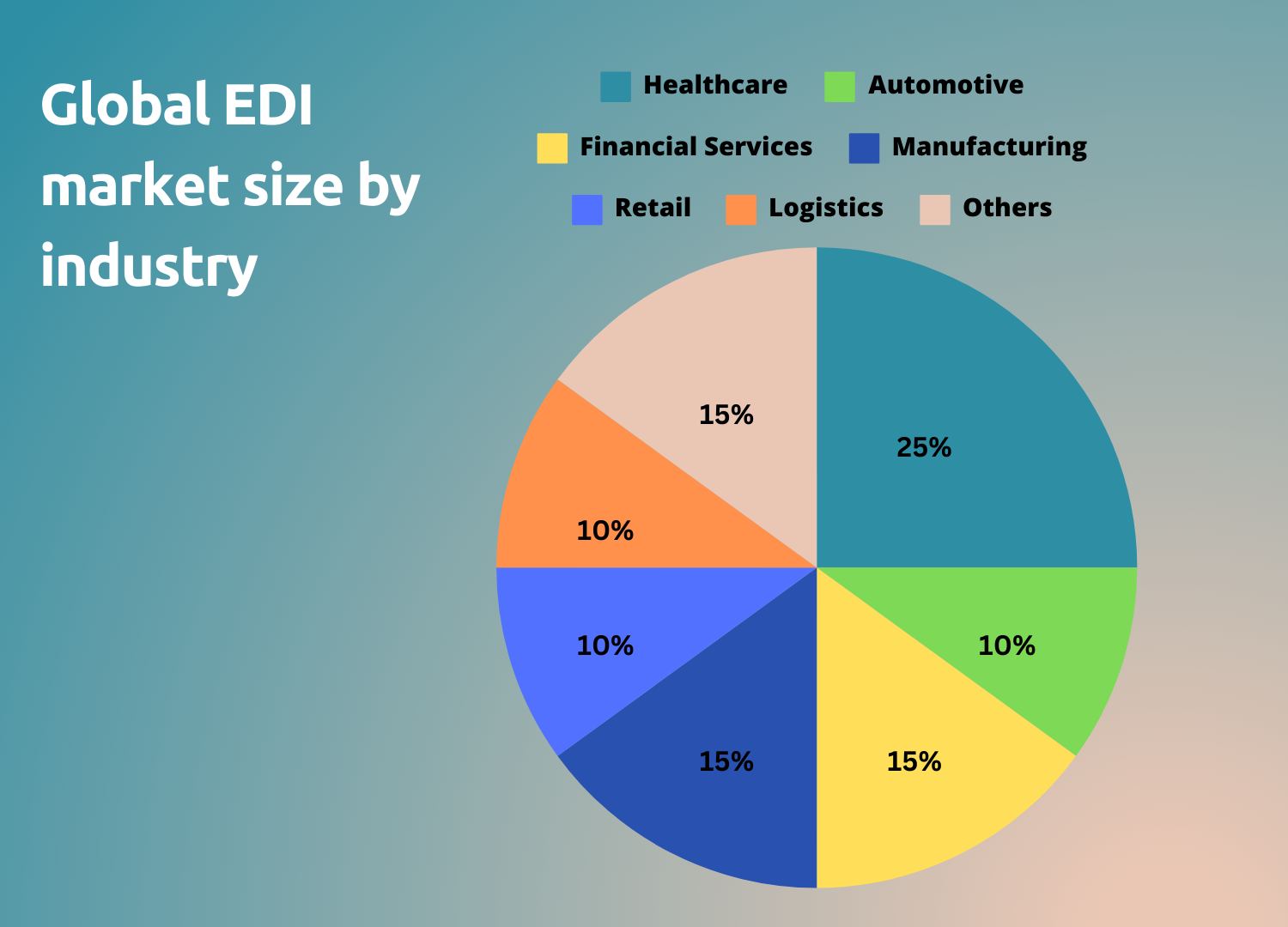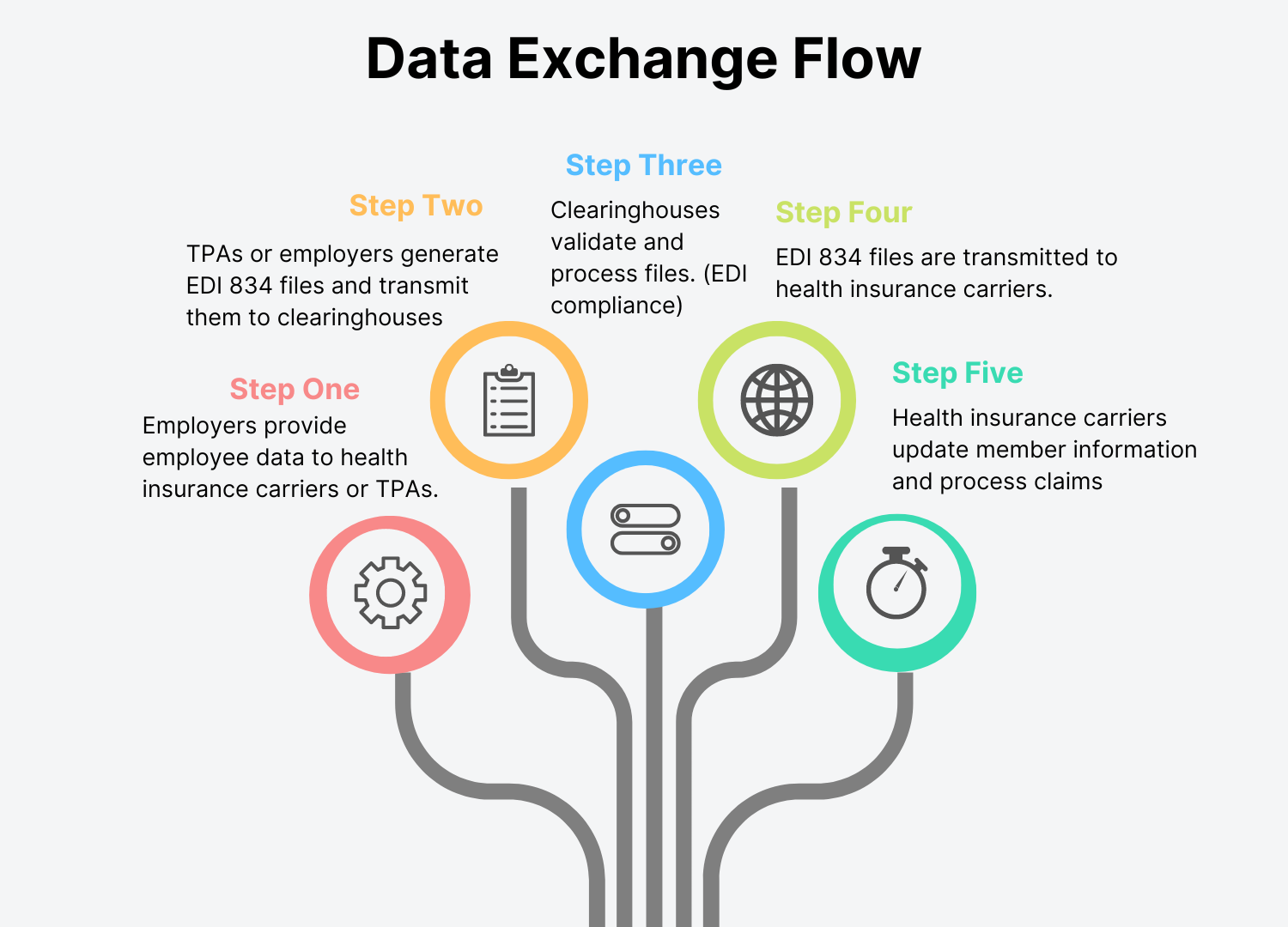Table of Contents
Businesses in the healthcare sector must continually deal with massive volumes of data, which call for prompt and accurate input to enable the sharing of documents between partners. Employers, government organizations, and health plans use the EDI 834 process transaction to enroll new employees and keep existing ones enrolled in a healthcare benefit plan.
Electronic eligibility and enrollment information interchange is standardized through the use of the 834 file style of EDI in industries especially in healthcare. In order to maintain accurate and effective data management between healthcare providers, insurers, and other relevant demographic partners with data handling and management responsibility for healthcare benefit plans, a standardized format that is a part of the Electronic Data Interchange standards is used.
The most crucial component of managing eligibility and enrollment for personal healthcare is the 834 file. EDI experts may transmit information more easily, rely less on human data entry, and make fewer mistakes thanks to the file standard.
Technologies in EDI like EDI 834 process enrollment files and 834 eligibility files assist enterprises in updating information, modifying coverage, and communicating enrollment status amongst various yet connected entities so that each can simplify administrative procedures and preserve correct records.

Introduction to EDI 834 Process
A document related to Benefits Enrollment and Maintenance is represented by the EDI 834 transaction set. Employers, unions, governmental organizations, and insurance companies utilize it to sign up members for health benefit plans. HIPAA 5010 guidelines have established the EDI 834 process for the electronic exchange of member enrollment data, which includes benefits, plan subscriptions, and employee demographic data. The following health plan-related uses for the EDI 834 services are possible:
- Fresh registrants
- Alterations to a member’s registration
- Reinstatement of a member’s eligibility for benefits
- Members’ dis-enrollment, or their removal from the plan
Employers usually provide the data to healthcare payer organizations, which handle the payment of medical claims and the administration of benefits and/or insurance. EDI services could include government organizations like Medicare and Medicaid, insurance corporations, and associations for healthcare professionals like HMOs and PPOs. A standard 834 EDI document could contain the following details:
- Name and identity of the subscriber
- Plan network identification
- Information on subscriber eligibility and/or benefits
- Identification of the product or service
An EDI 834 process transaction’s recipient is required to reply with a 999 Implementation Acknowledgement, which verifies that the file was received and offers commentary on the document’s acceptability.
Don’t Let The Stress of Open Enrollment(OE) Overwhelm You!
The EDI 834 Specification
The EDI 834 specification and implementation format and data contents are established in this X12 Transaction Set. This can be utilized in an Electronic Data Interchange environment. The payer and the insurance product sponsor can communicate with each other using this transaction set. These transaction(s) might go through a third-party administrator (TPA) or they might not. The sponsor is the party responsible for paying for the coverage, benefit, or product. An employer, union, association, government body, or insurance company can all serve as sponsors.
An organization that manages the insurance product or benefit, pays claims or does both is referred to as the payer. A payer may be a government agency (Medicare, Medicaid, Champus, etc.), an insurance company, a health maintenance organization (HMO), a preferred provider organization (PPO), or an organization that may be hired by one of the aforementioned groups. If a sponsor chooses not to carry out this task internally, they may hire a third-party administrator. They can help to manage the collection of data from individuals they cover for the purposes of the EDI 834 transaction set.

The Benefits of EDI 834
EDI 834 process allows the transmission and maintenance of enrollment data in a secure and consistent manner. The communication between the insurance providers, employers, and third-party administrators is also easier and more appropriately managed by EDI support specialists. Principal benefits include:
- Improve Efficiency : EDI 834 speeds up health plan updates, enrollment, and employee onboarding.
- Reduces Outlays: Since EDI 834 process automates the interchange of data, hence reducing administration outlays spent on paperwork, inefficient processing, human entry.
- Accuracy: EDI 834 guidelines ensure standardized formats with automated validation procedures, which enhance the accuracy of data and lower errors in enrollment data.
- Compliant: EDI 834 ensures secure, large-scale transfer of sensitive medical data between insurers and employers.
- Offers transparency: EDI 834 creates complete audit trails to maintain a record of every step in the enrolment process for accountability.
Key Players in the EDI 834 Process
Employers and health insurance providers depend on the EDI 834 procedure because it makes it easier for them to share enrollment data for health plans. Enrollment and benefit maintenance are made easier with these standardized EDI communication protocols, which also guarantees that all stakeholders have access to current and correct information. Comprehending the principal stakeholders involved in the EDI 834 process is imperative for proficient communication, teamwork, and operational effectiveness.
1. Health Insurance Carriers
Health insurance carriers are some of the most important players in the EDI implementation. They receive enrollment/eligibility data from employers or TPAs and manage member benefits, coverage, and claims. Health insurance carriers rely on the transaction set of EDI 834 process to:
- Update Member Information: Add, change or terminate coverage for employees according to the receipt of data.
- Ensure Compliance: Adhere to federal and state regulations for health insurance coverage and reporting.
- Increase Accuracy: Minimize chances of errors in member data to enable quick claims processing and better service for the customers.
2. Employers and Plan Sponsors
Employers and plan sponsors play a most critical role in the EDI 834 process. It is their responsibility to provide the right employee data about benefit enrollment to health insurance carriers in a timely manner. Some of their major responsibilities are below:
- Maintaining Employee Records: Maintain accurate employee demographic information, employment status, and benefit elections.
- EDI 834 Generation and Transmission: Go ahead and create and transmit EDI 834 service files to the health insurance carriers for any new hires, terminations, and changes in coverages.
- Ensure Data Accuracy: It is of grave significance to ascertain that the data received is accurate. So that there isn’t any delay in coverage and/or compliance issues.
3. Third Party Administrators
TPAs or EDI 834 service providers usually stand between employers and health insurance providers. They manage various administrative functions related to employee benefits, including the process of EDI 834. TPAs hereby help by smoothing the enrollment processes-they manage the creation and transmission of EDI 834 files on behalf of employers and consequently reduce administrative burdens for employers.
- Manage Compliance: All enrollment data sent out will be accurate and in compliance with applicable regulations.
- Coordinate Benefits: Coordination of benefits provided from health insurance providers and/or plan.
4. Clearinghouses
Clearinghouses are also one of the key stakeholders in the EDI 834 process. They are third-party EDI service providers in USA that offer different kinds of services in relation to EDI. These include integrating EDI system, validation, processing, and transmission of EDI files between employers, TPAs, and health insurance providers. The main services they provide are as follows.
- Data Validation: They validate the errors in EDI 834 files according to the needs, requirements, and contents.
- Error Resolution: Identifying and resolving errors in the data for prompt processing and coverages.
- Secure Transmission: EDI managed service providers offer a secure platform where sensitive health information can be exchanged to help protect against data breaches and comply with regulations like HIPAA.
5. Software Vendors
EDI software vendors are the entities that provide the tools and platforms used by employers, TPAs, and health insurance providers to compose, manage, and transmit EDI 834 files. Software vendors are very key to any success recorded in an EDI 834 process by providing solutions, including but not limited to the following:
- EDI Software: These platforms automate EDI file creation and sending, reducing manual work and errors.
- Data Integration Software: These are solutions that integrateswith the established systems for HR, payroll, and benefits management to ensure that data exchange is seamlessly done between them.
- Support and Training: Support and training are provided by electronic data interchange providers for stakeholders to use the software to the fullest and maintain regulatory compliance.
6. Governmental Institutions and Regulatory Bodies
This is why government agencies and regulatory bodies are put in place to monitor the process of EDI 834, ensuring all stakeholders are in compliance with relevant states, and laws provide consistency. These organizations set standards for EDI 834 transactions and ensure compliance as a way of protecting consumers and preserving the integrity of health insurance.
Key responsibilities include:
- Being the regulatory body: Setting the standards and guidelines for the various EDI transactions, including those of the EDI 834 format, so that all these transactions take place uniformly and correctly.
- Monitoring compliance: so that stakeholders work within the right regulations, including interest from the protection of health information under HIPAA.
- Imposition of fines and penalties: This is to safeguard the interests of the consumers and to ensure that the wheels of the industry continue to turn normally.
Accelerate Enrollment Processes with EDI 834
Conclusion
The possibility of errors that are vulnerable with faxes and paper communications decreases with the use of HIPAA 834. Fax handwriting is prone to misreading or misunderstanding. Furthermore, data entered manually runs the risk of being entered wrongly. Accuracy is consequently increased by using HIPAA 834. EDI Security is also another important benefit of electronic data transmission, including HIPAA 834. EDI training is necessary for healthcare providers to securely transmit requests for claim status information and receive responses, thanks to the HIPAA EDI rule. Additionally, EDI experts permit more efficient communication than paper-based methods. Errors in billing and shipping addresses were frequent before the HIPAA EDI Rule. This led to delays in healthcare claim processing, payment, and care, which in turn caused patient unhappiness and additional work for insurance companies and employers.
Fundamentally, the major players in the EDI 834 process are crucial to the enrollment procedure. Employers supply the data about their employees, insurance companies evaluate it, develop policies, and the government makes sure that it is followed. EDI consultants are essential for a smooth enrollment process, which in turn impacts the provision of high-quality healthcare to patients. To ensure optimal healthcare outcomes, EDI enrollment must operate smoothly with strong stakeholder collaboration.





